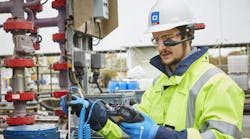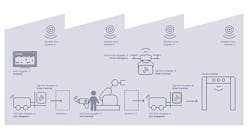Emerging from basic audio and video communications, one of the mobility technologies accelerating fastest lately is remotely linking operators and technicians with veteran experts. In-the-field users can employ combinations of cellular, WiFi, Internet and other links to show remote colleagues exactly what they're working on and get immediate details, notations and advice about how to proceed.
For example, Xervon Instandhaltung in Münchsmünster, Germany, provides onsite maintenance, repair and overhaul services to a variety of process industry clients. It recently enlisted Rise Technologies GmbH in Cologne, Germany, to help it implement RealWear's HMT-1 and explosion-proof HMT-1Z1 headsets, which are reported to be the first commercially available, hands-free, head-mounted, tablet-class PCs for hazardous areas (Figure 1). The basic unit consists of a hinged arm that fits below a hardhat's brim, a micro-display positioned 2 inches from the wearer's eye to appear as a 20-inch PC display or 7-inch tablet screen, voice-enabled controls, and a forward-facing camera, so others can see what the user sees. They're intended to aid maintenance, repairs and operations (MRO) tasks by letting field staff and expert colleagues interact more quickly and easily via immediate video calls, exchange case-related information, and find solutions quickly without bringing in-person experts onsite. Xervon is also considering dialing in contacts among its clients, who may have relevant knowledge, even if they're not onsite either.
"These headsets give us connections that function without problems in explosion-proof areas. Although they're not onsite, experts see the same things on their PC screens, laptops or smartphones as our employees at job sites," says Steven Brenner, head of maintenance engineering at Xervon. "Communications via audio and video streams eliminate the need for specially convened meetings for discussion, including time-consuming journeys. Processes can be accelerated enormously as a result."
Beyond enhanced, real-time collaboration, another major advantage of remote experts is documentation because their video interactions with field staff can be recorded, which allows important photos, sound bites and other data to be saved and shared. “If field employees notice something, they can save it not only as a sound recording but also as a photo, and store it digitally," explains Brenner. "This gradually creates a knowledge database. This knowledge about individual service cases can be called up again at any time, is available to other colleagues and can be used for similar situations."
Brenner adds that HMT-1 and HMT-1Z1 headsets even help field users solve small problems like orienting themselves in complex plants and other environments. "Despite comprehensive signposting, it can be difficult for outsiders to find their way around often large and nested plant complexes at first go," adds Brenner. "If employees are on duty, who don't yet know the exact route, a more experienced colleague can guide them directly and without unnecessary detours to the processes and devices that need to be inspected.”
Hands-free = hands-on
Sanjay Jhawar, cofounder and president of RealWear, reports, "If we look at field and plant-floor workers installing, maintaining and inspecting equipment though history, their tools evolved from clipboards to laptop PCs to tablets, smartphones and other handhelds, which usually need good WiFi connections. The overall push from no mobility to mobility is now moving from handhelds to hands-free, so users can manipulate devices more easily based on local information and consult with remote colleagues. This was already difficult with handhelds, but it's even harder if you're trying to keep on personal protective equipment (PPE) due to the pandemic."
Jhawar adds RealWear is observing two main trends accelerated by COVID-19, which have more than doubled its business in the past three to four months. "Fewer people are available onsite and many experts can't travel, and those that are onsite don't want to touch equipment or devices as much. So, as we work with industrial users, some are ready and able to deploy mobile technologies, while others are scrambling," says Jhawar. "We believe we're seeing a permanent shift in how people are accessing their equipment, and that even post-COVID-19, more mobile devices will continue to be used."
More recently, Total S.A. announced July 15 that it's deployed what's reportedly the first implementation of Microsoft Teams software on RealWear in the energy industry at its polypropylene plant in La Porte, Texas. As usual, linking Total's technical and engineering experts with headset-equipped operators will let them diagnose operations and maintenance issues, resolve them in real time, and improve their responsiveness safely in case of an unplanned event (www.youtube.com/watch?v=KqL-iMlBKjE).
“Connecting our field operators to Total’s experts and vendors, down the street or on the other side of the world, is particularly topical at a time when traveling is restricted,” says Eric Duchesne, senior vice president, Manufacturing and Project Division, Total Refining and Chemicals. "But above all, the launch of Microsoft Teams on RealWear at Total’s La Porte site in Texas is another step in our industrial digital transformation. It makes Total’s operations safer and more efficient by executing better decisions faster. It also allows us to improve our operational excellence over the long run, and create the petrochemicals plant of tomorrow.”
Adam Hale, maintenance execution superintendent at Total, adds that, "You put the HMT-1Z1 on your head, and you go hands-free. I can actually check vibrations and temperatures with my hands, I can work, turn wrenches or open a book. The potential is high."
'Ecosystem of interfaces'
RealWear's Jhawar agrees the ability to record and highlight mobile interactions can greatly help operations and maintenance at the scene, but it can also enable future users. "Instructions and advice from remote experts and mentors can be turned into micro-training videos, and then compiled into chapter-based video training courses. They can then be distributed on private YouTube channels or other formats, so less experienced staff can benefit from them. Just as with mainstream videos, users can rate these instructional versions, so others can find and use the best ones, rather than looking for text instructions that it's likely no one had the time to write down."
For example, Italy's largest natural gas distributor and pipeline operator, Italgas, started running its OverIT field service management software on RealWear's HMT-1Z1 platform in February, just before the nation began shutting down in March due to its devastating COVID-19 outbreak. The utility runs 44,000 miles of pipelines and 7.6 million assets, and adopted the headsets to support its digital transformation efforts, manage work orders and migrate beyond its tablet PCs with a purpose-built interface for restricted zones. Italgas reports HMT-1Z1 quickly delivered productivity gains by solving complex, risk-sensitive tasks, even in ATEX Zone 1 areas.
"We previously worked with Italgas' system integrator and software partner, and got them 100 of our HMT-1Z1s in December, so they were in already place and assisting their operations when COVID-19 hit Italy. Now, we're expanding that implementation to 300 units," says RealWear's Jhawar. "Usually, users have to look on one tablet PC for work orders and GPS locations, and consult P&IDs on another device. Now, we can scan QR codes from a tablet, and transfer orders hands-free with a headset that can access the user's server. This lets technicians at Italgas view flow conditions, check equipment maintenance, monitor their gas distribution points, and do the rounds for all their equipment on one device."
Because its headsets are actually wearable PCs that can be shaped into other forms, Jhawar adds that RealWear is developing an ecosystem of interfaces for users, system integrators and software suppliers. "We're really only limited by our partners' imaginations, so instead of cameras, we can attach thermal imaging sensors, and determine if equipment is getting too hot or if a person has a fever," adds Jhawar. "We can also add biometric sensors, such as a blood oximeter. In one pilot project, we're working with the N.Y. Power Authority and Zephyr on the EPRI bioharness, which adds body temperature, heart rate, blood oxygen and sweat salinity sensors to Zephyr's BioHarness system to detect heat stress in workers."






